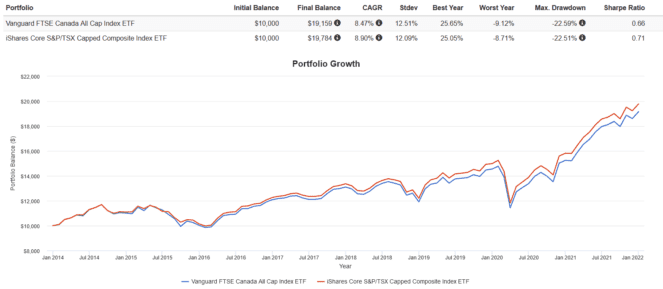When it comes to investing, the term “home-country bias” refers to when investors overweight their allocation of domestic stocks relative to international ones. For Canadians, this means keeping their allocation above 3%, which is the true world market cap weight.
Research shows that a moderate (20-30%) overweight has many benefits for a Canadian stock portfolio, including lower foreign withholding tax, reduced volatility, and less currency risk. Gaining exposure to can be difficult though. Picking and managing a portfolio of 15-30 stocks can be time consuming and prone to emotional mistakes.
Fortunately, fund providers like Vanguard and BlackRock have provided excellent exchange-traded funds (ETFs) at dirt-cheap prices that track the broad Canadian stock market.
Battle of the ETFs
Our choices come down to Vanguard VCN FTSE Canada All Cap Index ETF (TSX:VCN) vs. iShares Core S&P/TSX Capped Composite Index ETF (TSX:XIC). Both ETFs passively track the broad Canadian stock market, but with minor differences in their construction, depending on their reference index.
While VCN tracks the FTSE Canada All Cap Index, XIC tracks the S&P/TSX Capped Composite Index. These indexes have slight differences that shouldn’t affect performance too much, but are still notable. Firstly, XIC puts caps on the weightings of each underlying stock. This is to prevent any individual stock from getting so large as to dominate the index. Secondly, XIC has more holdings at 241 vs. 183 for VCN.
Other than that, the sector weights of VCN and XIC are nearly identical. Both have over 40% of their underlying holdings in the financial and energy sectors, which is typical for the Canadian stock market. Both ETFs also have the same top 10 holdings, with stocks like Shopify, Royal Bank, Toronto-Dominion Bank, Enbridge, Bank of Nova Scotia, Canadian National Railway, and Brookfield Asset Management dominating.
What the numbers say
When it comes to management expense ratios (MER), both ETFs are dirt cheap. VCN has an MER of 0.05%, while XIC has an MER of 0.06%. On a $100,000 portfolio, this works out to a difference of $10 a year, so its not worth fretting over, even if your portfolio is very large.
When it comes to dividends, VCN has a yield of 2.54% vs XIC at 2.43%. However, the yield price is affected by the current share price. Moreover, capital appreciation with dividends reinvested is the bigger picture, so we need to revisit this later once we look at their total return.
How have they performed?
A word of caution: the backtest results provide below are hypothetical in nature, do not reflect actual investment results, and are not guarantees of future results. Hypothetical returns do not reflect trading costs, transaction fees, or actual taxes due on investment returns.
From 2014 to present, with all dividends reinvested, both funds were essentially neck and neck, with very similar returns, risk, and drawdowns. XIC pulled ahead slightly in the recent years, likely because it held more stocks and could capture the growth of more small caps.

The Foolish takeaway
You really can’t go wrong with either ETF for your Canadian equity exposure. For an extremely low MER, you get instant access to hundreds of TSX stocks from large to small caps in every sector that are allocated based on their market weight.
Smart Canadian investors should highly consider pairing either XIC or VCN with a global all-cap ex-Canada ETF to create a long-term diversified stock portfolio. Holding a combination like this can be an easy, hands-off strategy to retire as a millionaire.



